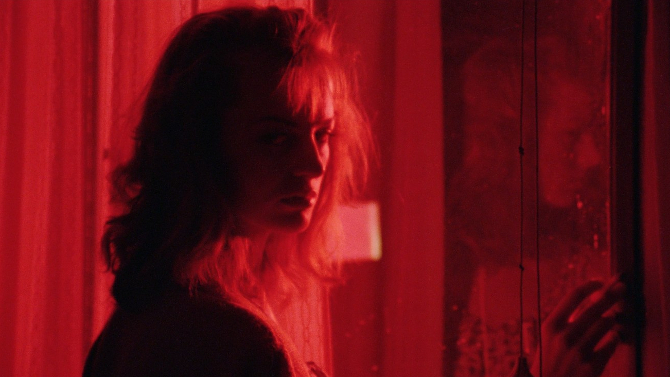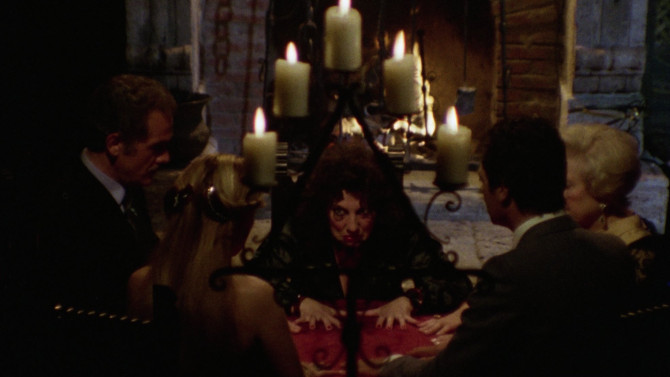
Murder ‘Mystery’
Sometimes a movie just doesn’t fit perfectly within its own genre... going against a few of the tropes that define what something is, all while hitting enough of them to still be what it is – confusing! That’s the case with this latter-day Italian giallo, Mystère... sometimes better known by its English title Dagger Eyes (1983). Co-written and directed by Carlo Vanzina, the film opens with a rather impressive, though more crime inspired assassination in Rome... resembling the real life John F. Kennedy car killing. It will start a chain reaction of murders that will rock the Eternal City.
-

Pyjama Parting
The Pyjama Girl CaseMay 26, 2020You know you’re in for a giallo when the word is literally in the Italian title. . . La Ragazza Dal Pigiama Giallo, simplified in English by being called The Pyjama Girl Case (1978), the word giallo, if you recall, is in reference to the garish yellow used on the covers of many of the books writers pulled from to create the films’ narratives – in this case, it is referencing the distinctive colour of the pyjamas the murdered girl was wearing when found. Written and directed by Flavio Mogherini, and based on a real case (the unsolved murder of Linda Agostini in 1934), this is a very rare giallo set in Australia, Sydney to be specific. A narrative about foreignness, nearly everyone in this Down Under landscape is an immigrant searching for a better life (though, as you will see, this isn’t always the outcome).
-

What Could Have Been: Malabimba
April 29, 2020Like The Exorcist hopped up on a lethal combination of steroids and Viagra, 1979's Malabimba, directed by envelope pushing Andrea Bianchi (for a reminder of his more well known work, think of his playfully edgy 1975 giallo Strip Nude for Your Killer), is an Italian motion picture not for the faint of heart. . . or you, like one of the characters in the film, might find yourself stone cold. Of course, reading this, I’m sure most will think that this is some sort of poorly done, sleazy exploitation piece attempting to capitalize on the aforementioned horror classic. And though the second sentiment is wholly true, the former is most definitely not so.
-

Some Like It Cold
Cold WarApril 26, 2020It is likely that any other year, outside of 2018, would have meant that a second one of Pawel Pawlikowski’s films would have won Best Foreign Language Film at the Academy Awards (the other is 2013's Ida). Instead, Alfonso Cuarón’s Roma (in its own right, a truly visionary film) froze out Cold War. Though this Polish export did achieve a nomination in the above mentioned category, as well as receive nods for Best Achievement in Directing and Best Achievement in Cinematography, it, in many ways, got overshadowed by another black and white foreign film released the exact same year. . . which is truly a shame. Set in post-war Poland – 1949, to be exact, Wiktor (Tomasz Kot), a very bourgeoisie musician (a dynamo who can play the piano, as well as write and arrange music) – bold, confident, and gifted, tours the countryside, recruiting the most talented teens and twenty somethings for a folk music ensemble that will tour Poland and the rest of the Eastern Bloc. One of the finds, Zula (Joanna Kulig), an undaunted singer, may not be the most pure talent, though she has that certain ‘je ne sais quoi’. With a mystifying persona, she is spark plug, femme fatale (both director and actress inspired by Lauren Bacall and her sarcastic delivery), and, somehow, ingénue. Wiktor has found his muse. . . love at first sight. . . the genesis of a change that you can never return from. A love affair blossoms.
-

Confusing Killer Titles for $500, Alex
Watch Me When I KillApril 21, 2020Produced towards the end of the giallo craze, director Antonio Bido’s 1977 film, which had different titles for the major markets in which it played. . . in Italy – The Cat with the Jade Eyes (good luck figuring out how this ties to the movie in any way), in the UK – The Cat’s Victims (again, loose ties at best), in the U.S. – Watch Me When I Kill (again, not very accurate), in France – Terror in the Lagoon (not sure where the Creature was. . . or the lagoon, for that matter), in Germany – The Vote of Death (finally one that may just make sense), takes the prototypical giallo themes and flips them on their head. Not psycho sexually driven or overly graphic in its violence, the story follows a guarded dancer, Mara (Paola Tedesco), who just seems to draw people in. Performing different routines on the stage of a nightclub (keep those minds out of the gutter everyone, think tango rather than striptease), Mara finds so-called filmmakers pestering her to join their project (hoping to get her into bed as well), a needy dance partner who is always keeping an eye on her, and her former fling, Lukas (Corrado Pani), coming around to rekindle their sporadic romance.
-

Shake `n Quake
The QuakeApril 14, 2020Norway is quickly becoming the master of the grounded disaster film. In 2015, The Wave received critical acclaim. . . three years later, the same creative team (including producer Are Heidenstorm and writers John Kåre Raake, Harald Rosenløw-Eeg) brought forth a sequel, The Quake, directed this time by John Andreas Andersen. If there was one complaint about the previous film, it is that there could have been a bit more depth in regard to the characters. Learning from their mistakes, The Quake takes place three years later. . . Kristian Eikjord (Kristoffer Joner) is deemed a hero by the country – though he does not feel one. Bogged down by the countless lives lost after the title wave hit the tourist town Geiranger, the now bearded man is in a fugue-like nervous state.
-

Love at First Fight
First LoveMarch 15, 2020Coming off a bit like an Asian version of a Quentin Tarantino/Guy Richie feature, First Love (2019) finds iconic Japanese director Takashi Miike (now with over one hundred films under his belt) in his favourite playground, fusing violence, comedy, crime, and romance together in a most entertaining way. An intricate ballet of characters shot at the pace of a hockey game, Leo (Masataka Kubota) is a lonesome boxer. . . an abandoned young man whose only skill is being a pugilist. Taking a limp-wristed punch during a bout, he unexpectedly crumples to the ground like a baby who has just realized that he can walk for the very first time. Medical investigation shows a tumour on the back of his brain – a death warrant. Seeing a street fortune teller (Bengal) soon after, he is frustrated at the man’s two views: one – that he is a healthy young man; and two – that he needs to have a cause and help people.
